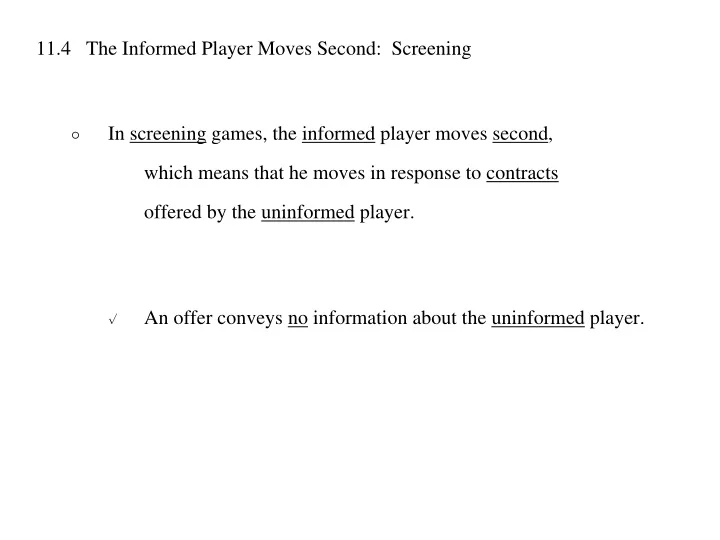

11.4 The Informed Player Moves Second: Screening In screening games, the informed player moves second , ð which means that he moves in response to contracts offered by the uninformed player. r An offer conveys no information about the uninformed player.
Education V: Screening with a Discrete Signal Players ð r a worker and two employers ð The order of play ability a − 0 Nature chooses the worker's {2, 5.5}, the Low and High ability each having probability 0.5. The variable is a observed by the worker, but not by the employers.
1 Each employer offers a wage contract w s ( ). education level s − 2 The worker chooses {0, 1}. 3 The worker accepts a contract, or rejects both of them. 4 Output equals . a
Payoffs ð 1 worker œ Î 8 if the worker accepts contract r w s a w 0 if he rejects both contracts 1 employer œ r a w for the employer whose contract is accepted 0 for the other employer
The unique equilibrium Education V has no pooling equilibrium. ð r If one employer tried to offer the zero profit pooling contract, œ w (0) 3.75, œ the other employer would offer (1) w 5.5 and draw away all the High s .
Separating Equilibrium 5.1 ð œ œ s Low ( ) 0 ( s High ) 1 r œ œ w (0) 2 (1) w 5.5 ð Beliefs do not need to be specified in a screening model. r The uninformed player moves first, so his beliefs after seeing the moves of the informed player are irrelevant .
The informed player is fully informed, r so his beliefs are not affected by what he observes. r This is much like simple adverse selection. The modeller does not need to refine perfectness in a screening model. ð
Education VI: Screening with a Continuous Signal ð Players a worker and two employers r The order of play ð ability a − 0 Nature chooses the worker's {2, 5.5}, each ability having probability 0.5. The employers do not observe ability, but the worker does .
1 Each employer offers a wage contract w s ( ). education level s − 2 The worker chooses [0, 1]. 3 The worker chooses a contract, or rejects both of them. 4 Output equals . a
Payoffs ð 1 worker œ Î 8 if the worker accepts contract r w s a w 0 if he rejects both contracts 1 employer œ r a w for the employer whose contract is accepted 0 for the other employer
A separating equilibrium Pooling equilibria generally do not exist in screening games ð with continuous signals, and sometimes separating equilibria in pure strategies do not exist either. ð Separating (Nash) Equilibrium 6.1 (with a unique equilibrium path) * œ œ r s Low ( ) 0 ( s High ) s * œ w s ( ) 2 if s s * 5.5 if s s
In any separating contract, r the Low s must be paid a wage of 2 for an education of 0, because this is the most attractive contract that breaks even. r The separating contract for the High s must maximize their utility subject to the constraints discussed in Education I. r the participation constraints for the employers * Ÿ œ Ÿ œ ñ w (0) a 2 and ( ) w s a 5.5 L H ñ Competition between the employers turns the inequalities into equalities .
the self-selection constraint for the s r Low * * * œ œ Î œ œ U s ( 0) (0) w 0 ( ) w s 8 s 2 U s ( s ) ñ L L s * œ This constraint is satisfied as an equality if 0.875, and ñ s * is true for higher values of . r the self-selection constraint for the High s * * * œ œ Î œ œ ñ U ( s s ) ( ) w s 8 s 5.5 (0) w 0 U ( s 0) H H s * ñ This constraint is true, regardless of the value of .
The education level for the s in Separating Equilibrium 6.1 is r High unique at 0.875, because the employers compete to offer the most attractive contract that satisfies the participation and incentive compatibility constraints. r The most attractive is the separating contract that Pareto dominates the other separating contracts s * œ by requiring the relatively low separating signal of 0.875.
Competition in offering attractive contracts rules out pooling contracts. ð r The nonpooling constraint, required by competition between the employers, is * * * œ œ Î ( ) ( ) 8 5.5 ( ). ñ U s s w s s U pooling H H r The nonpooling constraint is satisfied even with the most attractive possible pooling contract, œ which leads to ( ) 3.75. U pooling H
Recommend
More recommend